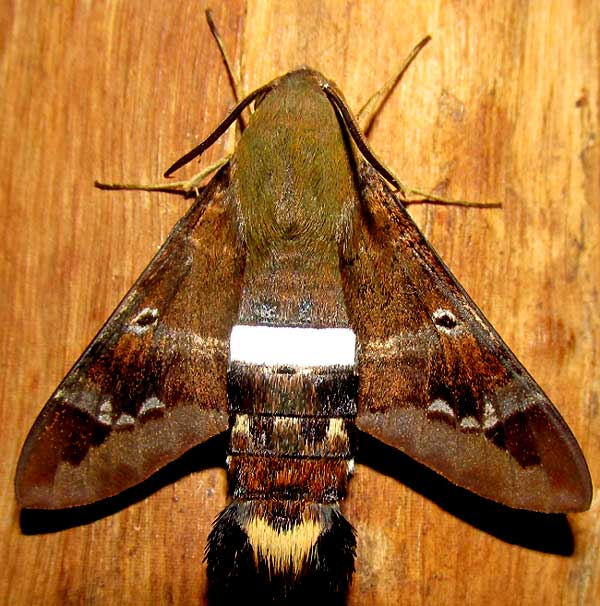Excerpts from Jim Conrad's
Naturalist Newsletter

from the November 22, 2015 Newsletter issued from Hacienda Chichen Resort beside Chichén Itzá Ruins, central Yucatán, MÉXICO
CLAVIPES SPHINX MOTH
Having finished my jog, built a campfire for hot water, and set myself to eating a steaming bowl of oatmeal with banana, with a bit of Maseca corn-flour thrown in for thickening, about an hour before dawn something thumb-sized with wings sounding like crinkling cellophane started bouncing against my left ear, then flew around my head to the right ear, and returned the left, before settling on the wood pole below the coil-shaped, super-efficient Tecno Lite light bulb dangling above my desk. It was a moth, having entered through the hut's open door and apparently confusing the light's reflection on my bald head for the Moon.
With its large size, swooped-back wings and thick body, it was obviously a sphinx moth, as you can see in the above flash-assisted photo.
Last year in Texas we saw a moth, the Titan Sphinx, that was so similar that at first I didn't bother to take the above picture. You can compare our oatmeal moth with the Texas one at www.backyardnature.net/n/a/aellopos.htm.
As I chewed the oatmeal, however, the moth just sat there at eyeball level, and I began to think how pleased volunteer identifier Bea in Ontario would be to have a moth to ID during Ontario's mothless November days, so I took the picture and sent it off.
Bea quickly replied that, yes, this Yucatan moth does look like the Texas one, but it's not quite identical. It's even in the same genus, Aellopos, but it's the Clavipes Sphinx, not the Titan Sphinx. It's AELLOPOS CLAVIPES.
"A variation on the sphinx moth theme," she reminded me to say in the Newsletter...
So, the Clavipes Sphinx ranges from Venezuela up through Central America and Mexico into California, Arizona and Texas. The larvae feed on various members of the Madder or Gardenia Family, the Rubiaceae, of which we have several species in our area, such as the very common Scarlet Bush, various species of buttonweed and planted Noni trees.
In our photograph, notice the long hairs at the tip of the moth's abdomen. Such hairs also were present on our Texas Titan moth. Back then we learned that such tufts of hair are known as hair-pencils, and that the hairs can be spread to provide more surface area to the air. Upon being spread, pheromones, or sexual hormones, are released from the moth's rear end. Both males and females have them. On our Titan Sphinx page I wrote:
"Not all moths bear hair-pencils but the males of species that do may use their hair-pencils to sprinkle pheromones right onto the female's antennae. This appears to have such an overwhelming effect on the female that not only is she roused sexually but also she becomes incapable of flying away. In certain lepidopterous species the pheromones thus sprinkled also keep other males away."